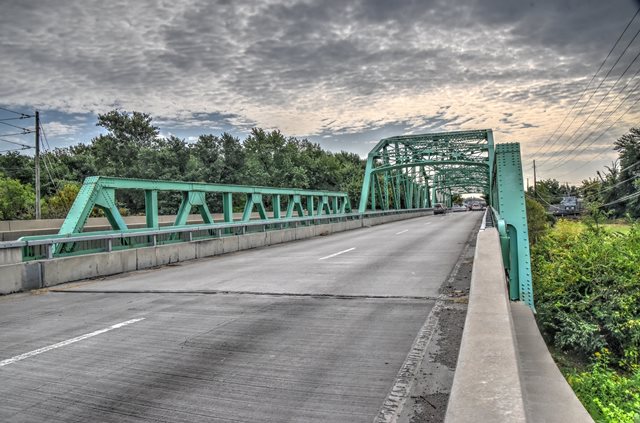We Recommend:
Bach Steel - Experts at historic truss bridge restoration.
Astronaut David Wolf Bridge

Primary Photographer(s): Nathan Holth
Bridge Documented: September 21, 2019
Indianapolis: Marion County, Indiana: United States
Metal 8 Panel Rivet-Connected Parker Through Truss, Fixed and Approach Spans: Metal 6 Panel Rivet-Connected Warren Pony Truss,
1942 By Builder/Contractor: B. E. Curry Building Corporation of Bloomington, Indiana and Engineer/Design: Indiana State Highway Commission
2008
175.0 Feet (53.3 Meters)
548.3 Feet (167.1 Meters)
30.8 Feet (9.39 Meters)
2 Main Span(s) and 2 Approach Span(s)
4900027

View Information About HSR Ratings
Bridge Documentation
This combination pony and through truss bridge has been turned into a one-way couplet with a modern bridge next to it.
View Archived National Bridge Inventory Report - Has Additional Details and Evaluation
View Historical Articles About This Bridge
View National Register of Historic Places Nomination Form For This Bridge
Information and Findings From DHPA Historic Bridge SurveyBridge History and Significance When at the advent of the Second World War and the 82nd-86th Street crossing operated as a part of SR #100, the ISHC decided to build a new four-span structure there. The state extended its standard planning for both the two Parker through-truss and the two Warren pony-truss spans it chose to have built there upon concrete piers and abutments. In the August 1941 bidding, the B. E. Curry Building Corporation of Bloomington, Indiana, secured the construction contract for $159,005.22, almost $40,000 less than the ISHC engineers had estimated. The ISHC used a fifth-generation standard plan #1551 for the 175-ft., riveted, Parker through- truss spans with 28-ft. roadways plus a pair of 2-ft. walks also inside the trusses. Truss depth varied from 23 ft. at the portal to 34 ft. 4 in. at midspan. Each truss carried eight panels, the outer two at 20 ft. 3 in. and the inner four at 23 ft. 6 in. Every top chord member is differently sloped; none is parallel with the lower chord; and all were fabricated from a pair of 15-in. channels (@40# for the endposts, third, and fourth panels, and @53.9# for the second). For the lower chord, 10-in. I-beams grow in weight from the outer panels (@66#) to the inner-most one (@100#). The state used rolled I-beams in some truss web members. The verticals or posts consist of two forms and weights: the hip and the fourth are 10-in. I-beams (@33#); the second and third are fabricated from a pair of laced 10-in. channels (@15.3#). To protect the quite-tall trusses against wind and vehicle-induced stress, substantial latticed struts and heavy upper sway framing buttress the verticals above 15 ft. of roadway clearance. The portals used latticed sections, too. While a 10-in. I-beam (@37#) provided the second-panel diagonal, the others used a pair of laced 10-in. channels (@15.3#). None of the panels was countered. The ISHC prescribed 33-in. I floor-beams (@200#) riveted to the verticals above the lower chord. Ten rows of rolled I-beam stringers attached to the floor-beams' sides varied in depth and weight by placement. The 20-ft. panels used 16-in. Is; the 23-ft. 6-in. ones relied on 18-in Is. Outside stringers were lighter than inner ones. Weights varied on 20-ft. panels from 36 lbs. (outer) to 50 lbs (inner); on the 23-ft. panels from 50 lbs to 55 lbs. Together, the floor-beams and the stringers carry the concrete deck. Angles supply each lower sway-bracing member. Tube-channel-and- post rails lined the inner sides of the trusses. The ISHC developed a new, late-generation standard (#1552) for its 96-ft. Warren pony-truss spans. The truss depth remained at 11 ft. and the panel length at 16 ft., all of whose members were riveted together. The external sway bracing disappeared, and the truss webbing was no longer manufactured from different kinds of sections. 10-in. rolled I beams of various weights supplied the verticals, the diagonals, and the lower chord members. The verticals were all at 54 lbs.; the diagonals ranged from 54 lbs. (outer) to 33 lbs. (midspan); and the lower chord members varied like the diagonals from 53 lbs. (outer) to 100 lbs. (central). 30-in. I floor-beams (@172# at the abutments; 190# across the span) were riveted to the verticals above the lower chord and, with the ten rows of rolled 16-in. Is (@36#) attached to their sides as stringers, carry the concrete deck with 15 feet of vertical clearance. Angles supply the lower sway bracing which was no longer designed as though double- intersecting. The ISHC used two important, late-generation standards for this structure. Less than a handful of examples survive of each standard. The trusses appear to retain all their original members, including the guardrails. The walks were eliminated when the deck was replaced. References Indiana State Highway Commission, Structure #534-C 49-3439; Contract #2204; Superstructure Standards #1551 & 1552. Bridge Considered Historic By Survey: Yes |
![]()
Photo Galleries and Videos: Astronaut David Wolf Bridge
Bridge Photo-Documentation
Original / Full Size PhotosA collection of overview and detail photos. This gallery offers photos in the highest available resolution and file size in a touch-friendly popup viewer.
Alternatively, Browse Without Using Viewer
![]()
Bridge Photo-Documentation
Mobile Optimized PhotosA collection of overview and detail photos. This gallery features data-friendly, fast-loading photos in a touch-friendly popup viewer.
Alternatively, Browse Without Using Viewer
![]()
Maps and Links: Astronaut David Wolf Bridge
Coordinates (Latitude, Longitude):
Search For Additional Bridge Listings:
Bridgehunter.com: View listed bridges within 0.5 miles (0.8 kilometers) of this bridge.
Bridgehunter.com: View listed bridges within 10 miles (16 kilometers) of this bridge.
Additional Maps:
Google Streetview (If Available)
GeoHack (Additional Links and Coordinates)
Apple Maps (Via DuckDuckGo Search)
Apple Maps (Apple devices only)
Android: Open Location In Your Map or GPS App
Flickr Gallery (Find Nearby Photos)
Wikimedia Commons (Find Nearby Photos)
Directions Via Sygic For Android
Directions Via Sygic For iOS and Android Dolphin Browser
USGS National Map (United States Only)
Historical USGS Topo Maps (United States Only)
Historic Aerials (United States Only)
CalTopo Maps (United States Only)

